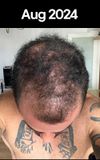community allergen of the year award list(2000-2023).most allergens are in every day shampoos and skin care.
The post discusses allergens in everyday shampoos and skincare products, listing yearly allergens from 2000 to 2023. It suggests that these chemicals might contribute to acne and hair loss.
